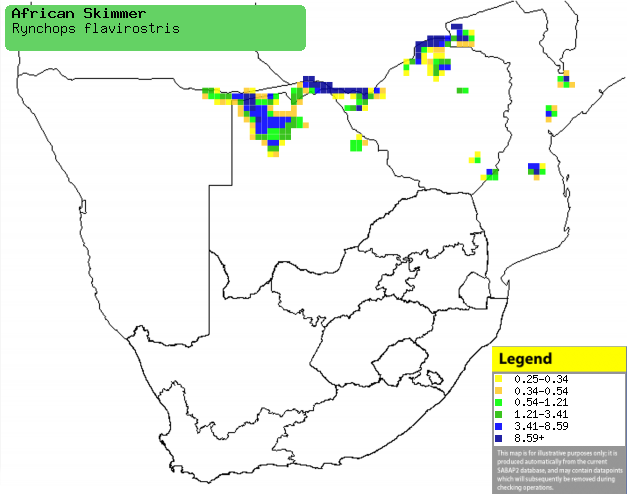|
Rynchops flavirostris (African
skimmer)
WaterploeŽr [Afrikaans]; Afrikaanse schaarbek [Dutch];
Bec-en-ciseaux d'Afrique [French]; Braunmantel-scherenschnabel [German];
Bico-de-tesoura-africano [Portuguese]
Life
> Eukaryotes >
Opisthokonta
> Metazoa (animals) >
Bilateria >
Deuterostomia > Chordata >
Craniata > Vertebrata (vertebrates) > Gnathostomata (jawed
vertebrates) > Teleostomi (teleost fish) > Osteichthyes (bony fish) > Class:
Sarcopterygii (lobe-finned
fish) > Stegocephalia (terrestrial
vertebrates) > Tetrapoda
(four-legged vertebrates) > Reptiliomorpha > Amniota >
Reptilia (reptiles) >
Romeriida > Diapsida > Archosauromorpha > Archosauria >
Dinosauria
(dinosaurs) > Saurischia > Theropoda (bipedal predatory dinosaurs) >
Coelurosauria > Maniraptora > Aves
(birds) > Order: Charadriiformes
> Family: Laridae
Distribution and habitat
Occurs across much of sub-Saharan Africa, absent from arid
and semi-arid areas. In southern Africa it is locally common in the Caprivi
Strip (Namibia), northern Botswana, northern Zimbabwe and central Mozambique. It generally prefers large rivers and lakes with expansive, exposed
sandbars and islands which are used for roosting and breeding.
|
 |
|
Distribution of African skimmer in southern
Africa, based on statistical smoothing of the records from first SA Bird
Atlas Project (©
Animal Demography unit, University of
Cape Town; smoothing by Birgit Erni and Francesca Little). Colours range
from dark blue (most common) through to yellow (least common). |
Predators and parasites
- Predators of eggs and chicks
Movements and migrations
Partial intra-African breeding migrant,
arriving in southern Africa when the water level of rivers starts
falling in the period from April-June, travelling north after
breeding when rivers start rising again from November-January.
Food
It almost exclusively eats small riverine fish, mainly hunting
at night as it has powerful nocturnal vision, although when feeding chicks it
often has to forage in the afternoon as well. It mainly forages using a unique
technique in which it flies low, with its oversized lower mandible
slicing through the water; if it touches something (such as a fish) the bird
instinctively shuts its bill to the capture the prey. The following food items have been recorded
in its diet:
- Fish
- Micralestes acutidens (Silver robber)
- Tilapia (tilapia)
- Barbus (barbs)
- Marcusenius macrolepidotus (Bulldog)
- Hepsetus odoe (African pike)
- Aplocheilichthys (topminnows)
- Petrocephalus catostoma (Northern churchill)
Breeding
- Monogamous, nesting either solitarily or in a colony of up to 25 pairs,
sometimes along with other birds such as
Collared pratincoles,
Pied avocets
and White-fronted
plovers.
- The nest is probably built by both sexes, consisting of a deep scrape in the ground (which is often damp), usually
digging multiple
scrapes before selecting one. It is typically placed close to the water
level on a riverine sandbar.
- Egg-laying season is mainly from August-October.
- It lays 2-4 eggs, which are incubated by both sexes for about 20-22
days.
- The chicks leave the nest within 1-2 days of hatching, led to the water
by the parents, who shade them in the heat of the day and
regularly feed them. They eventually take their first flight at about 5-6
weeks old, after which they are still fed by both adults for some time. The
adults are vigilant in the defence of their young, mobbing predators and
sometimes carrying their young to safety in their bill.
Threats
Near-threatened globally and probably Endangered
in southern Africa, due to habitat loss, disturbance and exploitation, such
as the harvesting of chicks and eggs as well as boats which flood nests in their
wake.
References
-
Hockey PAR, Dean WRJ and Ryan PG 2005. Roberts
- Birds of southern Africa, VIIth ed. The Trustees of the John Voelcker
Bird Book Fund, Cape Town.
|
